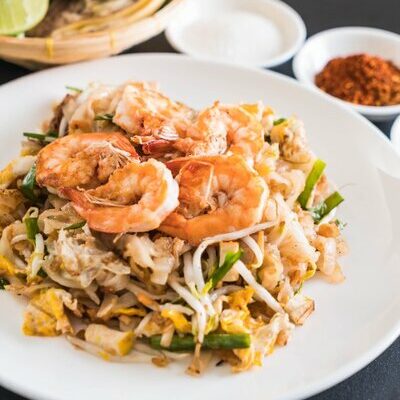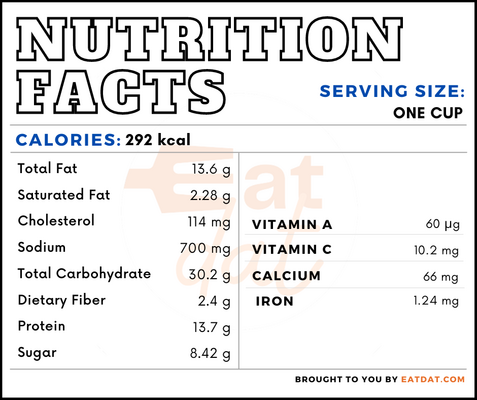
Pad Thai
What is Pad Thai?
Pad Thai is a Thai dish made with rice noodles and containing meat, peanuts, eggs, bean sprouts, and vegetables. The noodles used are rather thick and broad, and are known as rice stick. The meat used is often shrimp but sometimes chicken, beef, and pork is also used. The dish is fried and then flavored with a sauce made up of chili garlic sauce, tamarind paste, palm sugar, fish sauce, garlic, and shallot.
- This dish is considered street food in Thailand and has a combination of salty, nutty, and mildly sweet flavors.
- The name itself means Thai style stir fried noodles.
Some of the most popular brands of rice stick noodles are:
- Roland
- Erawan
- Asian Best
- Three Elephants
Origin of pad thai
This dish has its roots in Chinese cuisine. Traders from China introduced it into Thailand a few centuries ago but it remained an obscure dish. In the 1930s, the Thai Prime Minister, Plaek Phibunsongkhram, wanted to use food as a means of engendering national unity. He changed the country’s name from Siam to Thailand, and tweaked the Chinese dish to add sauces that were quintessentially Thai. It became extremely popular across the country and was named the national dish of Thailand.
Nutrition
Nutritional profile for Pad Thai (shrimp) (1 cup):

Pad Thai is a rich source of micronutrients such as calcium, phosphorous, potassium, sodium, magnesium, selenium, vitamin C, folate, choline, vitamin A, retinol, carotene, cryptoxanthin, lutein zeaxanthin, and vitamin K.
Commercial production
Pad Thai is found throughout the country, and the street food stalls are especially renowned for this dish. Also, it is available in Thai restaurants throughout the world. In fact, it is probably the most famous Thai dish.
To prepare pad Thai, the ingredients required are rice noodles, tofu or shrimp, eggs, bean sprouts, roasted peanuts, shallots, garlic, dried shrimp, chai po waan (sweet radish pickle), chilli flakes, and garlic chives. For the sauce, tamarind paste, palm sugar, fish sauce, and chili sauce are required.
For the first step, the rice noodles must be soaked in water for about an hour. In the meantime, the sauce can be prepared by first melting the palm sugar in a pan until it is caramelized. A little splash of water is then added along with the other sauce ingredients. Then, it is blended and allowed to sit. The shrimp is cooked and kept aside. After that, the vegetables, tofu, chili flakes, and dried shrimp are chopped and sauteed in a pan to which the soaked noodles and sauce are added.
Then, the noodles are stir fried until fully coated with the sauce. In the same pan, the fried noodles are pushed to one side and the eggs are cracked on, then covered with the noodles and allowed to cook for a few seconds. This is tossed and then the dish is garnished with the peanuts, bean sprouts, and garlic chives. It is again tossed to cook the sprouts. Finally, the cooked shrimp is added along with some more peanuts and a slice of lime.
Pad Thai recipes
This is a pretty standardized dish with only a few ingredients. The flavors may change due to the sauces containing different proportions of the ingredients. Here are a few variations of this recipe.
FDA regulations
There is no available standard of identity for pad thai or rice noodles.
References
David Farley, The quest for the perfect pad Thai, BBC Travel, https://www.bbc.com/travel/article/20150415-the-quest-for-the-perfect-pad-thai
Cheenkaew, Yanyong et al. “Southern-style Pad Thai sauce: From traditional culinary treat to convenience food in retortable pouches.” PloS one vol. 15,5 e0233391. 21 May. 2020, doi:10.1371/journal.pone.0233391, https://www.ncbi.nlm.nih.gov/pmc/articles/PMC7241765/
